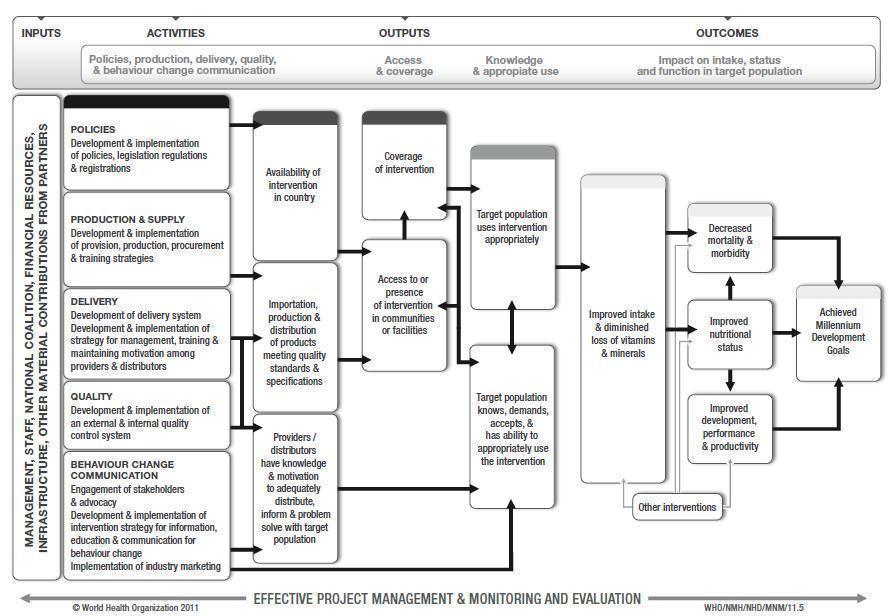Fortification of rice with vitamins and minerals for addressing micronutrient malnutrition
Información
- DOI:
- https://doi.org/10.1002/14651858.CD009902Copiar DOI
- Base de datos:
-
- Cochrane Database of Systematic Reviews
- Versión publicada:
-
- 13 junio 2012see what's new
- Tipo:
-
- Intervention
- Etapa:
-
- Protocol
- Grupo Editorial Cochrane:
-
Grupo Cochrane de Salud pública
- Copyright:
-
- Copyright © 2012 The Cochrane Collaboration. Published by John Wiley & Sons, Ltd.
Cifras del artículo
Altmetric:
Citado por:
Autores
Contributions of authors
Joseph Ashong drafted an initial protocol with technical input from Sumithra Muthayya, Arnaud Laillou, Luz Maria De‐Regil and Juan Pablo Pena‐Rosas. Luz Maria De‐Regil, Belinda Burford and Juan Pablo Pena‐Rosas developed the methods of the protocol. All authors provided input and contributed to drafting the final version of the protocol.
Disclaimer: Luz Maria De‐Regil and Juan Pablo Pena‐Rosas are full time staff member of the World Health Organization. The authors alone are responsible for the views expressed in this publication and they do not necessarily represent the official position, decisions, policy or views of the World Health Organization.
Sources of support
Internal sources
-
Centre for Health Innovation and Parntership, NSW Health, North Parramatta, Australia.
Sumithra Muthayya is a full time staff member of the Centre for Health Innovation and Partnership, NSW Health, North Parramatta, Australia
-
Sight and Life, Switzerland.
Joseph Ashong worked in this protocol during his internship at the Department of Nutrition for Health and Development, WHO, Geneva. JA received financial support for his internship from Sight and Life.
-
Global Alliance for Improved Nutrition (GAIN), Switzerland.
Christophe Guyondet, Arnaud Laillou and Regina Moench‐Pfanner are full‐time staff of GAIN, Switzerland.
External sources
-
Evidence and Programme Guidance Unit, Department of Nutrition for Health and Development, World Health Organization, Switzerland.
Dr Belinda Burford received partial financial support from the Department of Nutrition for Health and Development for this work.
-
Global Alliance for Improved Nutrition (GAIN), Switzerland.
WHO thanks GAIN for their financial support for conducting systematic reviews on micronutrient interventions. SM received partial financial support from GAIN for this work.
-
Centers for Disease Control and Prevention (CDC), USA.
The National Center for Birth Defects and Developmental Dissabilities provided financial support for conducting this systematic review.
Declarations of interest
Regina Moench‐Pfanner, Arnaud Laillou and Christophe Guyondet are full time staff of the Global Alliance for Improved Nutrition (GAIN), a Swiss‐based non‐government organization that supports fortification programmes in developing countries, including rice.
Joseph Ashong ‐ none.
Luz Maria De‐Regil ‐ none.
Belinda Burford ‐ none.
S Muthayya ‐ none.
Juan Pablo Pena‐Rosas ‐ none.
Acknowledgements
We would like to thank the Cochrane Publc Health group for its support in the preparation of this protocol. As part of the pre‐publication editorial process, this review will be commented on by external peers (an editor, and two referees who are external to the editorial team) and one of the Group's statisticians.
Version history
| Published | Title | Stage | Authors | Version |
| 2019 Oct 25 | Fortification of rice with vitamins and minerals for addressing micronutrient malnutrition | Review | Juan Pablo Peña‐Rosas, Prasanna Mithra, Bhaskaran Unnikrishnan, Nithin Kumar, Luz Maria De‐Regil, N Sreekumaran Nair, Maria N Garcia‐Casal, Juan Antonio Solon | |
| 2012 Jun 13 | Fortification of rice with vitamins and minerals for addressing micronutrient malnutrition | Protocol | Joseph Ashong, Sumithra Muthayya, Luz Maria De‐Regil, Arnaud Laillou, Christophe Guyondet, Regina Moench‐Pfanner, Belinda J Burford, Juan Pablo Peña‐Rosas | |
Keywords
MeSH
Medical Subject Headings (MeSH) Keywords
- Anemia, Iron-Deficiency [prevention & control];
- Avitaminosis [*prevention & control];
- *Food, Fortified;
- Malnutrition [prevention & control];
- *Micronutrients [administration & dosage, deficiency];
- Minerals [*administration & dosage];
- Oryza;
- Randomized Controlled Trials as Topic;
- Vitamins [*administration & dosage];
Medical Subject Headings Check Words
Adolescent; Adult; Child; Child, Preschool; Female; Humans; Male; Pregnancy; Young Adult;
PICO

WHO/CDC logic model for micronutrients interventions in public health (with permission from WHO)
| Forms of rice | Description of rice |
| Rough rice (paddy rice) | Rice kernels still enclosed in an inedible, protective hull |
| Brown rice | Rice with only the hull removed. Bran layers and rice germ remain, giving the rice a brown colour |
| Parbolied rice | Rice pressurized to gelatinised the starch within the rice kernel, resulting in a firmer,more separate grain that is more stable and less susceptible to overcooking than regular‐milled white rice |
| Regular‐milled white rice (Milled rice) | Polished whole rice, or polished rice. hull, bran layer and germ have all been removed |
| Precooked rice | Regular milled white rice, parboiled milled white rice, and brown rice can be precooked and dehydrated before packaging. Examples of precooked rice are quick‐cooking rice, instant rice, and boil‐in‐the‐bag rice |
| Individually Quick Frozen (IQF) rice | Cooked grains are individually frozen before packaging |
| Crisped/Puffed/Expanded Rice | Kernels can be processed in a number of different ways and shapes to meet particular manufacturing need |

